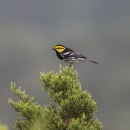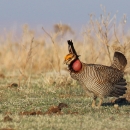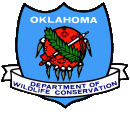States
Colorado, Kansas, New Mexico, Oklahoma, TexasLesser Prairie-Chicken
Tympanuchus pallidicinctus
- Range: The lesser prairie-chicken currently occupies a five-state range that includes portions of Colorado, Kansas, New Mexico, Oklahoma and Texas.
- Status: Northern DPS-Proposed Threatened; Southern DPS-Proposed Endangered
About the lesser prairie-chicken
The lesser prairie-chicken is emblematic of the grasslands of the southwest, a treasured and storied American landscape of great importance to the people who call the area home. It is a species of prairie grouse commonly recognized for its colorful spring mating display and stout build.
While historical estimates suggest lesser prairie-chickens once numbered in the hundreds of thousands or even millions across nearly one hundred million acres, populations have declined drastically due to habitat loss and fragmentation. It is estimated that lesser prairie-chicken habitat has diminished across its historical range by about 90 percent.
Lesser prairie-chickens need large tracts of relatively intact native grasslands and prairies to thrive, and are considered a "boom-bust" species with annual reproductive success tied to precipitation patterns.
The Service, in cooperation with state wildlife agencies, private landowners and other partners, is working to conserve the lesser prairie-chicken and the native grasslands and prairies that support the species.
Listing Under the Endangered Species Act
The U.S. Fish and Wildlife Service listed two Distinct Population Segments (DPS) of the lesser prairie-chicken under the Endangered Species Act (ESA) in 2023. The Southern DPS of the lesser prairie-chicken is listed as endangered. The Northern DPS of the lesser prairie-chicken is listed as threatened with a section 4(d) rule designed to tailor protections.
The Southern DPS encompasses lesser prairie-chicken populations in eastern New Mexico and across the southwest Texas Panhandle. Habitat in this population segment is comprised largely of shinnery oak prairie. The Northern DPS encompasses lesser prairie-chicken populations in southeastern Colorado, southcentral to western Kansas, western Oklahoma and the northeast Texas Panhandle. This DPS includes the lesser prairie-chicken’s short-grass, mixed-grass and sand sagebrush sagebrush
The western United States’ sagebrush country encompasses over 175 million acres of public and private lands. The sagebrush landscape provides many benefits to our rural economies and communities, and it serves as crucial habitat for a diversity of wildlife, including the iconic greater sage-grouse and over 350 other species.
Learn more about sagebrush ecoregions.
Lesser Prairie-chicken Listing Decision Information
Partners in Lesser Prairie-Chicken Conservation
For over two decades, we've been working with our federal, state and private partners to facilitate the conservation of the lesser prairie-chicken and its habitat. These partnerships have resulted in a number of conservation efforts for the lesser prairie-chicken. Together we have made great strides, including raising awareness and conserving key habitat, but we still have a long way to go for a sustainable, long-term impact.
Learn more about these partnerships and agreements benefitting the lesser prairie-chicken.


















